CHAPTER 23 After reviewing this chapter, you should be able to: 1. State the importance of calculating heparin dosages accurately 2. Calculate heparin dosages being administered intravenously (mL per hr, units per hr) 3. Calculate subcutaneous dosages of heparin • Mix-ups with concentrations of heparin • Temporary increases in heparin pump rates to give a bolus; error caused by staff forgetting to reset the pump after delivering the bolus • Tenfold overdoses from using the abbreviation “U” for units • Various concentrations of IV heparin bags and heparin vials being mixed up, in part because of look-alike vials and bags These are just a few reasons for errors that have occurred with heparin. The U.S. Pharmacopoeia listed heparin as one of the top 10 medications most frequently involved in medication errors. The Joint Commission proposed a 2008 National Patient Safety Goal (NPSG) associated with anticoagulation therapy. The goal is to reduce the likelihood of patient harm associated with this form of therapy. The requirements will apply to all organizations that provide anticoagulation therapy. The implementation expectations began January 1, 2009. These requirements can be viewed on The Joint Commission’s web site at www.jointcommission.org. Figure 23-1 shows the various heparin dosage strengths. The client requires continuous monitoring while receiving heparin because of the risk for hemorrhage or clots with an incorrect dosage. Dosages of heparin are highly individualized and based on a client’s coagulation time. Lovenox (enoxaparin) and Fragmin (dalteparin) are also injectable low-molecular-weight anticoagulants prescribed for prevention and treatment of deep vein thrombosis (DVT) and pulmonary emboli (PEs) after knee and hip surgery. (Figure 23-2 shows a Lovenox label and a vial of Fragmin.) Order: Heparin 7,500 units subcut Available: Heparin labeled 10,000 units per mL What will you administer to the client? 1. No conversion is necessary. There is no conversion for units. 2. Think—what would be a logical dosage? 3. Set up in ratio and proportion, the formula method, or dimensional analysis and solve. The dosage of 0.75 mL is reasonable because the ordered dose is less than what is available. Therefore less than 1 mL will be needed to administer the dosage. This dosage can be measured accurately only with a tuberculin syringe (calibrated in tenths and hundredths of a milliliter). This dosage would not be rounded to the nearest tenth of a milliliter. A tuberculin syringe illustrating the dosage to be administered is shown in Figure 23-3. Calculating the rate in units/hr can be done by using ratio and proportion or dimensional analysis. • Isolate units/hr being calculated first. • Place the 20,000 units per 1,000 mL as the starting fraction with units in the numerator, to match the units in the numerator being calculated. • Enter the 30 mL/hr rate with 30 mL as the numerator; notice that this matches the starting fraction mL denominator. • Cancel the mL to obtain the desired unit (units/hr). • Reduce if possible, and perform the necessary math operations. • Isolate mL/hr being calculated first. • Enter the starting fraction 25,000 units per 500 mL, placing mL as the numerator. Notice that this will match the mL numerator of the units being calculated. • Enter the 850 units/hr rate ordered with units in the numerator. • Cancel units; 50 mL and hr are left.
Heparin Calculations
HEPARIN ERRORS
CALCULATION OF SUBCUTANEOUS DOSAGES
Example:
CALCULATION OF IV HEPARIN SOLUTIONS
Using Ratio and Proportion to Calculate Units per Hour
Using Dimensional Analysis to Calculate Units per Hour
Steps:

Calculating mL/hr From Units/hr
Example 1:
Steps:
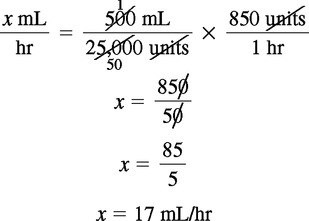
![]()
Stay updated, free articles. Join our Telegram channel

Full access? Get Clinical Tree





 Solution Using Ratio and Proportion
Solution Using Ratio and Proportion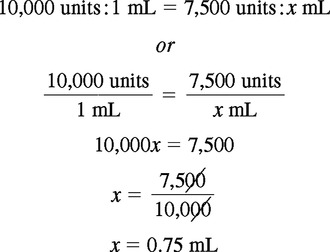
 Solution Using the Formula Method
Solution Using the Formula Method
 Solution Using Dimensional Analysis
Solution Using Dimensional Analysis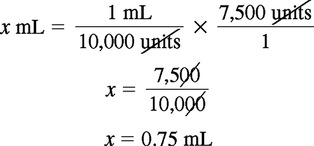


 Solution Using Ratio and Proportion
Solution Using Ratio and Proportion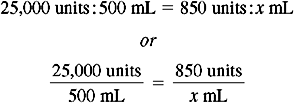
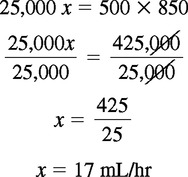
 Solution Using Ratio and Proportion
Solution Using Ratio and Proportion